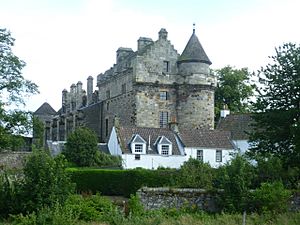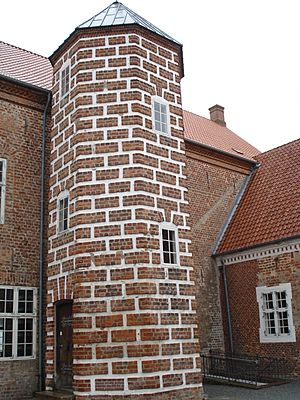Peder Munk facts for kids
Peder Munk of Estvadgård (born 1534, died 1623) was an important person in Denmark's history. He was a skilled sailor, a politician, and a special messenger (ambassador) for his country. He was in charge of the ships that took Anne of Denmark to Scotland to marry King James VI. This journey later led to some unusual events, including accusations of witchcraft in both Denmark and Scotland.
Contents
Who Was Peder Munk?
Peder Munk was born on April 22, 1534, in a place called Lønborggård in Denmark. His father was Ludvig Munk and his mother was Kirstin Pedersdatte Lykke. Peder had a younger brother, Ludvig Munk, who was also a sailor and soldier. Peder's niece, Kirsten Munk, later married Christian IV of Denmark, who became king.
From 1566, Peder Munk's main home was an estate called Estvadgård, located in Skive.
In 1575, Peder Munk became the Admiral of Denmark. This was a very high position, meaning he was the main commander of all the Danish ships. In 1588, he was part of the Rigsraadet, a special council that helped rule Denmark while the young King Christian IV was growing up. It's said that Peder Munk even gave the young king a miniature warship to play with in a lake!
On August 20, 1589, Peder Munk and other Danish officials signed an agreement in Helsingør. This agreement was about the Scottish islands of Orkney. It was part of the plans for the marriage between King James VI of Scotland and Anne of Denmark, who was the sister of King Christian IV.
A Royal Voyage to Scotland
In August 1589, the Danish council decided that Peder Munk, along with Breide Rantzau, Dr Paul Knibbe, and Niels Krag, would go with Anne of Denmark to Scotland. She was going there to marry King James VI. Peder set sail on September 5 with Henrik Knudsen Gyldenstierne, who was the admiral of the fleet, and 18 ships.
Some of the ships in their fleet were the Gideon, the Josaphad (their main ship), the Samson, Joshua, Dragon, Raphael, St Michael, Gabriel, Little Sertoun, Mouse, Rose, Falcon of Birren, Blue Lion, Blue Dove, and White Dove.
Winter in Norway
Before they even left Copenhagen, there were two accidents on the ships involving cannons exploding. The fleet was then delayed by very strong and difficult winds. They first found a safe place to stop in Norway, where the ship Gideon was repaired because it was leaking. They then stopped at Flekkerøy. Some of the ships, like the Samson, St Michael, and Joshua, had to return to Copenhagen.
Meanwhile, in Scotland, King James was waiting for his bride at Seton Palace. He even wrote a poem about the strong winds that were stopping the queen from arriving! During this time, a ferry boat on the River Forth crashed with another ship in a storm. Everyone on the ferry drowned, including a lady named Jane Kennedy who was supposed to join the queen's household. Later, in 1590, people started to believe that these accidents and the problems with the royal ships were caused by witchcraft.
King James VI sent some Scottish messengers, including William Stewart and John Skene, to Anne in Norway. They sailed to Copenhagen and told the Danish officials about the problems the fleet was facing. Anne of Denmark decided to stay in Norway. King James then decided to sail to Norway himself to bring her back to Scotland.
Return to Scotland and Royal Gifts

King James VI and Anne of Denmark finally returned to Scotland on May 1, 1590, with the rest of the Danish fleet. Peder Munk, Breide Rantzau, and Steen Brahe came as special messengers. When they arrived in Leith, King James gave gifts of gold coins to the captain of Munk's ship, the pilots, and the musicians. Peder Munk himself received a beautiful jewel.
Before Anne's official crowning (coronation) in Edinburgh, Peder Munk traveled to see the lands that King James VI had given Anne of Denmark as a special wedding gift, called a "morning gift". This gift was made official with a special document that had the king's seal on it.
Munk first visited Rossend Castle and stayed at Wemyss Castle. On May 12, they visited Falkland Palace. Then, on May 13, they went to Dunfermline Palace and later to Linlithgow Palace. At each palace, a lawyer named John Skene read out the details of the property. Then, Peder Munk was given a handful of earth and stones. This was a traditional Scottish ceremony to show that ownership of the land was being officially transferred.
Back in Edinburgh, on May 17, the day of the queen's coronation, Peder Munk, Steen Brahe, and Breide Rantzau walked with Anne of Denmark into Holyrood Abbey. They were followed by other important people who carried the queen's long dress.
On May 18, Munk and Lord Hamilton walked with Anne of Denmark into St Giles' Cathedral for her official entry into the town. A few days later, the town of Edinburgh held a big dinner party for the Danish messengers, the king, and the queen. It was held in a fancy house decorated with tapestries, and there were musicians and guards. Peder Munk and the other Danish messengers received gold chains as diplomatic gifts.
Witchcraft Accusations
After Peder Munk returned to Denmark, he became involved in a disagreement with Christoffer Valkendorff, who was in charge of money and government in Copenhagen. This was about how the fleet was prepared and if the ships were faulty. Around this time, some women in Copenhagen were accused of witchcraft. People believed they had caused storms or damaged the ships that were supposed to take Anne to Scotland. For example, a woman named Anna Koldings and others were accused of meeting to put "little devils" onto the ships.
News of these arrests reached Scotland by July 1590. The English ambassador, Robert Bowes, wrote that the Danish Admiral (Peder Munk) had arrested five or six witches in Copenhagen. They were suspected of using witchcraft to stop the Queen of Scots' journey to Scotland and to stop the King's return.
In October 1590, a Danish diplomat named Dr Paul Knibbe wrote that Peder Munk's fleet had been threatened by witches. He mentioned a woman named Margrete, who was accused of leading these witches. Munk went with the accused couple to their trial. Margrete was found guilty, and her husband's possessions were taken away.
In Scotland, several people were also accused of trying to sink the royal ships using magic. These were known as the North Berwick witch trials. One of the accusations against a woman named Agnes Sampson was that she raised winds to stop the queen from sailing to Scotland. The safe return of King James VI and Anne of Denmark from this "conspiracy of witches" was celebrated at the special event for their son Prince Henry in August 1594.
Scotland Visit in 1591
It is believed that Peder Munk returned to Scotland as an ambassador in August 1591 with many followers. He spoke with King James VI about some disagreements between Anne of Denmark and the Scottish Chancellor, John Maitland.
Important Roles and Family Life
On July 29, 1590, Munk was with King Christian IV and his mother, Sophie of Mecklenburg-Güstrow, at Koldinghus palace. They hosted the Scottish messengers John Skene and William Stewart. At dinner, the messengers were given a special honor by sitting at the same table as the king and other important Danish officials, including Munk.
From 1596 to 1608, Peder Munk held another very important position: Marshal of the Realm. This meant he was the commander of all the Danish armed forces.
Peder Munk married Karen Skeel in 1566. She was the daughter of Albert Skeel and Kirsten Sandberg. Their family symbols from 1568 can still be seen carved in a church at Borre.
On July 29, 1604, he married Sophie Pedersdatter Brahe.
Peder Munk also visited England with King Christian IV in 1606. King James gave him a gift of fancy gold plates.
From 1589, Munk owned a large house called Sæbygård. In 1621, he sold his old home, Estvadgård.
Peder Munk passed away in 1623 at a manor called Sødringholm, which he had bought in 1592. He was buried on March 31 at Volstrup Church.
His wife, Sophie Brahe, later sold Sødringholm in 1625. She then lived at Sæbygård, where she had part of the house rebuilt. Their daughter, Kirsten Munk (who died in 1624), and Sophie were also buried at Volstrup.
Peder Munk also had a house in Copenhagen. In 1607, a woman named Anna Busch Walker, who said she could see the future, wrote a special book for Anne of Denmark. She wrote that she was born in Peder Munk's house in Copenhagen, in an area that was once a naval base.


